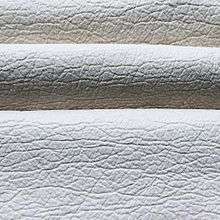Piñatex
 Piñatex fabric in white | |
| Inventor | Dr Carmen Hijosa |
|---|---|
| Manufacturer | Ananas Anam |
| Website | www.ananas-anam.com |
Piñatex is a natural leather alternative made from cellulose fibres extracted from pineapple leaves, Piñatex was developed by Dr Carmen Hijosa and first presented at the PhD graduate exhibition at the Royal College of Art, London. Piñatex manufactured and distributed by Dr Hijosa's company Ananas Anam Ltd.[1]
Development
Piñatex began to be developed when Dr Hijosa was working as consultant in the leather goods industry in the Philippines in the 1990s. She observed the leather produced there by was poor quality, unsustainable for the environment and bad for the people involved in the industry.[2] Inspired by the barong tagalog, a traditional transparent garment worn over shirts in the Philippines made of pineapple fibres Dr Hijosa spent seven years developing the product through a PhD at the Royal College of Art in London and joint collaborations with Bangor University in Wales, Northampton Leather Technology Center, Leitat technological Centre in Spain, alongside NonWoven Philippines Inc. in Manila, and Bonditex S.A., a textile finishing company in Spain.[2][3][4]
Production
Piñatex is created by felting pineapple leaf fibres together to create a non-woven substrate.[1][5] The pineapple industry globally produces 40,000 tonnes of waste pineapple leaves each year, which are usually left to rot or are burned.[1] Approximately 480 leaves (the waste from 16 pineapple plants) are needed to create 1 square metre of material. The material uses the long leaf fibres which are separated by the pineapple farmers for additional income, the leftover biomass from the process can be used as a fertilizer.[5][4][5][1]
Because Piñatex is produced from a waste product it requires no additional land, water, pesticides or fertilizers. It also avoids the use of formaldehyde and heavy metals used in animal leather production and has none of the wastage of leather caused by the shape of the animal's skin.[1][2]
 Making Piñatex, decorticating pineapple leaves
Making Piñatex, decorticating pineapple leaves After the fibre from the pineapple leaves is decorticated and washed the farmers hang it up to dry
After the fibre from the pineapple leaves is decorticated and washed the farmers hang it up to dry
Properties
Piñatex can be produced in different thicknesses, dyed a range of colours and finishes including a metallic finish. It can also be printed on, stitched and treated to give different types of texture.[4] Piñatex is vegan and unlike petroleum based synthetic leather it is degradable.[2]
Uses
Piñatex is breathable and flexible and is suitable to create bags, shoes and accessories, seat coverings and other furnishings. The textile is being further developed for use in clothing.[5] Products have been produced by designer Ally Capellino, Time IV Change, ROMBAUT and NaeVegan and prototypes have been created by Puma and Camper.[2][4]
Recognition
In 2016 Piñatex won the Arts Foundation UK award for Material Innovation and in 2015 Dr Hijosa was finalists of the Cartier Women's Initiative Awards.[6][1] Piñatex is a PETA certified vegan fashion label.[7]
External links
References
- 1 2 3 4 5 6 "Leather alternative Piñatex is made from pineapple leaves". Dezeen. 2016-06-09. Retrieved 2016-09-16.
- 1 2 3 4 5 "This Gorgeous, Sustainable "Leather" Is Made From Pineapple Waste". 2016-04-25. Retrieved 2016-09-17.
- ↑ "Vegan Leather Made From Pineapples is Cruelty-Free and Biodegradable". Retrieved 2016-09-16.
- 1 2 3 4 Hickey, Shane (2014-12-21). "Wearable pineapple fibres could prove sustainable alternative to leather". The Guardian. ISSN 0261-3077. Retrieved 2016-09-17.
- 1 2 3 4 "Leather alternative replaces animal hide with pineapple leaves | Science! | Geek.com". @geekdotcom. Retrieved 2016-09-16.
- ↑ "Carmen Hijosa | Award Editions". award-editions.cartierwomensinitiative.com. Retrieved 2016-09-17.
- ↑ "Our Company - ananas anam". Retrieved 2016-09-16.